Graphene Air Purification Device in the New Olympic Edition Fuxing High-Speed Train
The new Olympic Edition Fuxing high-speed train, customized for the Beijing Winter Olympics, builds on the operational experience and advanced technology of the Beijing-Zhangjiakou high-speed railway. This train boasts smart, eco-friendly, and human-centered features.
The train consists of 8 cars, with a 4-car powered and 4-car unpowered arrangement. The exterior design features a “Snow Welcoming Spring” theme, using ice-blue tones accented with white ribbons, snowflakes, and sports elements to highlight the Winter Olympics theme.
Equipped with cutting-edge “high-speed rail + 5G + 4K” technology, the 5G Winter Olympics train creates the world’s first high-speed rail 5G ultra-HD Olympic studio, enabling live 4K broadcasts of Olympic events across six channels.

In terms of technology and intelligence, the train not only features automatic driving capabilities but also incorporates power batteries and auxiliary driving technology for intelligent emergency operations, setting a world precedent. It is the first to use the Beidou Satellite Navigation System and is equipped with a gigabit Ethernet network, providing seamless global internet connectivity.
For energy efficiency, the train utilizes lightweight technology, environmentally degradable materials, a graphene air purification system, and a gray water recycling system to create a green, low-carbon space. The bionic design of the train’s front reduces operational resistance by 7.9% and overall energy consumption by more than 10%. To ensure safety, the train is equipped with over 2,700 monitoring points and advanced technologies such as cloud computing, big data, and artificial intelligence. It features a fault prediction and health management system, forming an integrated “train-air-ground” intelligent maintenance system. The comfortable and private business seats, cultural screens, Chinese knot ceiling lamps, and Olympic elements reflect the train’s Olympic and cultural heritage.
Knowledge Expansion: How Does Graphene Work in Air Purification?
Graphene’s application in air purification devices leverages its unique physical and chemical properties, making it highly effective in this field.
- High Adsorption Capacity: Graphene has a large specific surface area and high porosity, which allows it to adsorb various pollutants from the air effectively, such as volatile organic compounds (VOCs) and fine particulate matter (PM2.5).
- Flexibility and Thinness: As a two-dimensional carbon nanomaterial composed of a hexagonal lattice of carbon atoms, graphene’s structure gives it high flexibility and thinness. This makes it suitable for use in various forms, such as nano-filtration membranes, aerogels, and functional coatings in air purification devices.
- Antibacterial Properties: Graphene and its derivatives, like graphene oxide, have antibacterial and antiviral properties, which enhance the effectiveness of air purification systems.
- Photocatalytic Activity: Some graphene air purification devices integrate photocatalytic technology, where UV light activates the graphene surface to generate free radicals that break down harmful substances in the air. This technology not only improves air purification efficiency but also releases negative ions, increasing the concentration of oxygen ions in the air and improving air quality.
Graphene air purification devices, with their high efficiency, durability, and low energy consumption, have promising potential and market prospects. As technology advances and costs decrease, graphene is poised to become a revolutionary material in the field of air purification.

